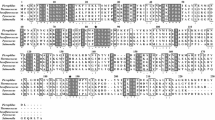Abstract
3-Methylaspartase was purified 24-fold and crystallized from the crude extract of the cells of a facultative anaerobic bacterium from soil, strain YG-1002. The molecular mass of the native enzyme was about 84 kDa and that of the subunit was about 42 kDa. The pH optimum for the deamination reaction of (2S, 3S)-3-methylaspartic acid and those for the amination reaction of mesaconic acid were 9.7 and 8.5; its optimum temperature was 50°C. The enzyme was stable at pH 5.5–11.0 and up to 50°C. The enzyme required both divalent and monovalent cations such as Mg2+ and K+. The enzyme was inhibited by sulfhydryl reagents, metal-chelating reagents and some divalent cations. The enzyme catalyzed the reversible amination/deamination reactions between several 3-substituted (S)-aspartic acids and their corresponding fumaric acid derivatives. The enzyme preferentially acted on (2S, 3S)-3-methylaspartic acid and mesaconic acid in the deamination and the amination reactions respectively. The enzyme showed high similarities in several enzymological properties and N-terminal amino acid sequence with 3-methylaspartase from an obligate anaerobic bacteriumClostridium tetanomorphum.
Similar content being viewed by others
References
Akhtar M, Botting NP, Cohen MA, Gani D (1987) Enantiospecific synthesis of 3-substituted aspartic acidsvia enzymic amination of substituted fumaric acids. Tetrahedron 43:5899–5908
Asano Y, Kato Y (1994) Occurrence of 3-methylaspartate ammonialyase in facultative anaerobes and their application to synthesis of 3-substituted (S)-aspartic acids. Biosci Biotechnol Biochem 58:223–224
Barker HA (1981) Amino acid degradation by anaerobic bacteria. Annu Rev Biochem 50:23–40
Barker HA, Smyth RD, Wawszkiewicz EJ, Lee MN, Wilson RM (1958) Enzymic preparation and characterization of an α-L-\-methylaspartic acid. Arch Biochem Biophys 78:468–476
Barker HA, Smyth RD, Wilson RM, Weissbach H (1959) The purification and properties of β-methylaspartase. J Biol Chem 234:320–328
Barker HA, Smyth RD, Bright HJ, Ingraham LL (1961) β-Methylaspartase fromClostridium tetanomorphum. Methods Enzymol 5:827–832
Botting NP, Cohen MA, Akhtar M, Gani D (1988) Primary deuterium isotope effects for the 3-methylaspartase-catalyzed deamination of (2S)-aspartic acid, (2S,3S)-3-methylaspartic acid, and (2S, 3S) 3-ethylaspartic acid. Biochemistry 27:2956–2959
Bradford MM (1976) A rapid and sensitive method for the quantitation of microgram quantities of protein utilizing the principle of protein-dye binding. Anal Biochem 72:248–254
Brenner DJ (1986)Enterobacteriaceae. In: Krieg NR, Holt JG (eds) Bergey's manual of systematic bacteriology, Vol. 1. Williams & Wilkins, Baltimore London, pp 408–516
Buckel W, Barker HA (1974) Two pathways of gutamate fermentation by anaerobic bacteria. J Bacteriol 117:1248–1260
Butler T (1975) Mechanism of action of aspartase. Diss Abstr Int B Sci Eng 36:1683
Gharbia SE, Shah NH (1991) Pathways of glutamate catabolism amongFusobacterium species. J Gen Microbiol 137:1201–1206
Goda SK, Minton NP, Botting NP, Gani D (1992) Cloning, sequencing, and expression inEscherichia coli of theClostridium tetanomorphum gene encoding β-methylaspartase and characterization the recombinant protein. Biochemistry 31:10747–10756
Hanson K, Havir EA (1972) The enzymic elimination of ammonia. In: Boyer PD (eds) Enzymes, 3rd edn. Academic Press, New York, pp 75–166
Hsiang MW, Bright HJ (1969) β-Methylaspartase fromClostridium tetanomorphum. Methods Enzymol, 13:347–353
Laemmli UK (1970) Cleavage of structural proteins during the assembly of the head of bacteriophage T4. Nature 227:680–685
Nuiry II, Hermes JD, Weiss PM, Chen C-Y, Cook PF (1984) Kinetic mechanism and location of rate-determining steps for aspartase fromHafnia alvei. Biochemistry 23:5168–5175
Perkin NH (1888) Chlorofumaric and chloromaleic acids and the magnetic rotatory power of some of their derivatives. J Chem Soc 53:695–713
Rudolph FB, Fromm HJ (1971) The purification and properties of aspartase fromEscherichia coli. Arch Biochem Biophys 147:92–98
Takagi JS, Tokushige M, Shimura Y, Kanehisa M (1986)L-Aspartate ammonia-lyase and fumarate hydratase share extensive sequence homology. Biochem Biophys Res Commun 138:568–572
Walden P (1891) Zur kenntniss der tetrinsäure, oxytetrinsäure und ihrer homologen. Chem Ber 24:2035
Winkler MF, Williams VR (1967) Substrates for β-methylaspartase. Biochim Biophys Acta 146:287–289
Author information
Authors and Affiliations
Rights and permissions
About this article
Cite this article
Kato, Y., Asano, Y. 3-Methylaspartate ammonia-lyase from a facultative anaerobe, strain YG-1002. Appl Microbiol Biotechnol 43, 901–907 (1995). https://doi.org/10.1007/BF02431926
Received:
Revised:
Accepted:
Issue Date:
DOI: https://doi.org/10.1007/BF02431926




